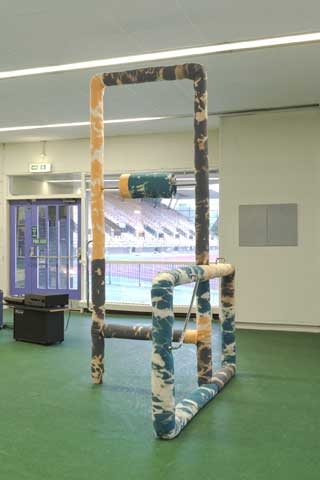One of the things I like about my job – or more generally about being somebody who goes out looking at art – is that it takes you to places you would probably never find yourself otherwise. Even if these places are pretty mundane and do not appear in the guidebooks for a good reason. The thought first struck me when I was staying in Genk, the small, rather dull former mining town in Belgium that was the venue for last year’s Manifesta. And it comes to the fore again as the guy in the polo shirt and shorts behind the reception desk at an Edinburgh leisure centre gives me a series of increasingly complicated instructions on how to find a particular room within the sports complex. I already know that, rather than finding Collective gallery’s latest off-site project, I’m going to end up in a Zumba class.
I do find the exhibition eventually, installed in a small gym space overlooking the running track. I don’t take up the offer to walk on Heaven Is a Place on Earth (2007), a floor work featuring a grid of red, white and blue bathroom scales by Jacob Dahlgren. Not after I’ve passed all the toned and sweaty squash players on my way here – that would not be a self-esteem boost. A semicircular installation of record players and other audiovisual equipment by Haroon Mirza hums in the corner; a series of c-print triptychs depicting odd, fictional gym sports by Nilbar Güres hangs on the wall; and a soft fabric-covered sculpture by Rachel Adams in the form of an oversize, comically impractical exercise frame stands in the middle of the room. It’s an odd experience, looking at all this stuff as joggers run round the track on the other side of the glass doors and kids practice football skills on the pitch. The reasons it’s all here, as opposed to in a gallery space, are twofold. The show, Game Changer, is part of a series of ongoing projects that Collective has been staging in venues that were used for the 1970 and 1986 Commonwealth Games in Edinburgh or will be used for the 2014 incarnation in Glasgow. There’s obviously ideals of public engagement being appealed to here – something the gallery has had to take seriously since evolving around the early 1990s from being primarily supported by artist subscriptions to receiving a budget provided by the public purse – but it’s an approach the gallery finds curatorially interesting as well.
Collective emerged from Edinburgh’s artist populace in August 1984 as an artist-run space, and up until 1990 its primary responsibility was to its subscription-paying artist members. A voluntary committee of artists administered the organisation, programming a mix of solo and group shows of mainly Edinburgh College of Art graduates. In 1990, however, Collective was under pressure from the Scottish Arts Council (as the body was then named) to ‘professionalise’, if their minimal funding was to be improved upon. The salaried role created as a result of that has now expanded to eight staff positions and a more institutional setup. Happily, younger artist-run spaces, such as Embassy and Rhubaba, have moved to fill the void left by Collective in the city’s art ecosystem. Nonetheless, its history is what ingrains the gallery in the city – more so than many of its institutional peers that were professional from the off.
Collective is relocating, moving a steep but very pretty ten-minute walk away from the space in the heart of Edinburgh old town where the gallery has been located for over a decade, to the city’s handsome, domed Victorian former observatory building. And it is using this time between locations to encourage its would-be visitors to explore the city. Besides the leisure centre show, there’s a series of audio tours – the current one a poetic exploration authored by Ruth Ewan and Astrid Johnston – which lead the listener around Edinburgh, a form of programmatic self-reflection perhaps for a gallery that has had such a long and varied position within the capital.
This article was first published in the October 2013 issue.
